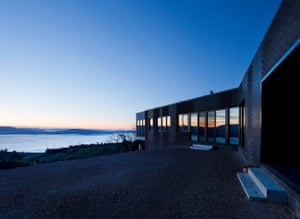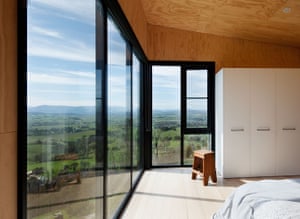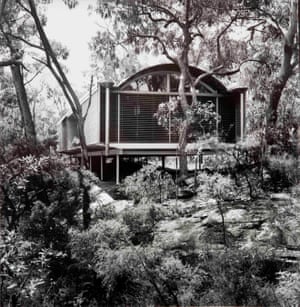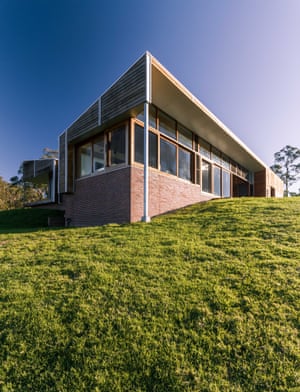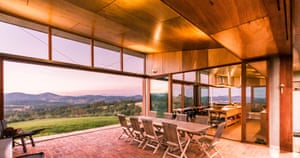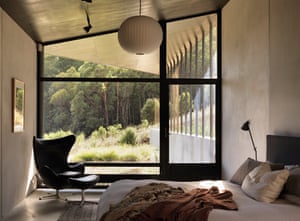BUILDING FIRE PROOF HOUSES
CLICK ON ABOVE CAPTION TO FIND OUT MORE
Bushfire-proof houses are affordable and look good – so why aren't we building more?
After the deadly Black Saturday bushfires in Victoria, architects provided free consultations and designs for bushfire-resistant homes. Only a few were built

Alexandra Spring
Tue 9 Feb 2016 10.12 AEDT
Last modified on Tue 9 Feb 2016 10.14 AEDT
Comments156
Comments156
A bushfire resistant, earth sheltered house at Narwee, created by Baldwin O’Bryan Architects, which won the Bushfire Building Council 2015 Innovation Design award. Photograph: Bushfire Building Council
In June 2009, not long after Victoria’s Black Saturday bushfires claimed 173 lives and destroyed more than 2000 houses, a group of architects came together to help those who had been affected.
As part of the Victorian bushfire reconstruction and recovery authority’s We will Rebuild initiative, they offered free consultations and 19 customisable pro bono designs, which were environmentally sustainable and met the “higher end” of the building standards for those in bushfire prone areas. Surprisingly only a few of those homes were built.
In June 2009, not long after Victoria’s Black Saturday bushfires claimed 173 lives and destroyed more than 2000 houses, a group of architects came together to help those who had been affected.
As part of the Victorian bushfire reconstruction and recovery authority’s We will Rebuild initiative, they offered free consultations and 19 customisable pro bono designs, which were environmentally sustainable and met the “higher end” of the building standards for those in bushfire prone areas. Surprisingly only a few of those homes were built.
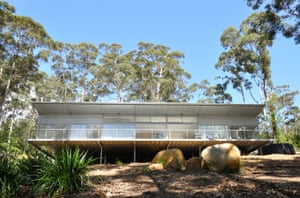
FacebookTwitterPinterest Created by architects Ian Weir and Kylie Feher, Karri fire house, in Denmark, Western Australia, was designed for a professional firefighter. Photograph: Andrew Halsall/Ian Weir Architects
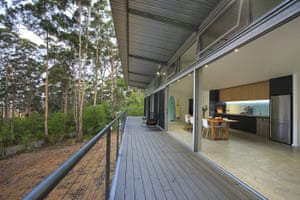
FacebookTwitterPinterest Those who live in Karri fire house, in Denmark, Western Australia, wanted a verandah to enjoy the bushland but needed it to be bushfire resistant. Photograph: Andrew Halsall/Ian Weir Architects
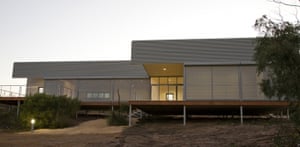
FacebookTwitterPinterest Another of Ian Weir’s bushfire resistant designs is H (heath) house 2007, in Point Henry, Western Australia. Photograph: Andrew Halsall/Ian Weir Architects
Since then, regulations have been stepped up, and there are more bushfire resistant products on the market including bushfire resistant windows, doors and timber (pdf). Yet as the devastating fires in Wye River and Separation Creek in December and in Yarloop-Waroona in January demonstrated, bushfire resistant homes are still not being built in vulnerable areas.
Research architect Ian Weir, a spokesman for the Bushfire Building Council of Australia (BBCA), is known for his bushfire resistant designs. He says there’s a large market for them but surprisingly few architects are interested. This is despite the fact that significant homes have long been designed with this in mind.
He points to eminent architect Glenn Murcutt, who incorporated bushfire resistant features into many of his designs, including the Laurie Short house (1973), the Ball-Eastaway house (1980) and Simpson-Lee house (1993) in the Blue Mountains.
Murcutt’s innovations include black ceramic house tiles that reflect radiant heat, permanent water features on flat roofs, conspicuous sprinkler systems and leaf-shedding gutter designs. Murcutt has “a long history of doing bushfire responsive houses,” Weir says, “and they are never talked about in that way.”
The Christmas Hills house, created by architect Clare Cousins and her team was designed and documented pro bono for a couple whose house was destroyed in Black Saturday fires in Victoria. Photograph: Shannon McGrath/Clare Cousins
One of the few pro bono designs created for those affected by the Black Saturday fires in Victoria, to be realised was designed by architect Clare Cousins and her team. Photograph: Shannon McGrath/Clare Cousins Architects
The bushfire resistant Ball-Eastaway house in Glenorie New South Wales, was designed by Glenn Murcutt. Photograph: Anthony Browell/Architecture Foundation Australia
One of the reasons Weir believes more houses weren’t built from the 19 designs is that they were too prototypical and expensive. The residents in bushfire prone areas still wanted quite conventional houses, Weir says. “They would have seen those houses as a bit foreign, a bit alien.”
Bushfire-resistant homes don’t have to look bizarre, he says. “[I] work with people that are adamant they want something that looks conventional, and so I’ve had to deliver that.”
They can also be affordable, he says. His Karri fire house design was created for a professional firefighter who lives in a bushfire prone area. The house cost about A$500,000 (£245,000) but only about 5% of the budget went towards satisfying the highest fire standard, the BAL-40.
One of the few We will Rebuild designs that was taken up was done by the Victorian architect Clare Cousins. Her Hinge house design was used to rebuild a home in Christmas Hills. Cousins says her team wanted to offer an affordable architectural-designed option to those affected. Their design was originally priced at around A$270,000 (£13,200), and Cousins believes this was one of the main reasons it was selected. It met the second highest of the requirements, BAL-29 when it was built.
These days Cousins is working with a large housing developer to design sustainable, well-designed and affordable homes, that have bushfire resistance included in their designs. “I don’t think that needs to be a completely unique product, it’s something that can be considered as part of a whole house.”
A bushfire resistant home by Austin McFarland Architects was shortlisted for 2015 New South Wales architecture awards. Photograph: Russell McFarland/Architect Institute
Interiors for Austin McFarland Architects’s acclaimed and bushfire resistant home. Photograph: Russell McFarland/Architect Institute
Bushfire proofing can – and should – be incorporated into everyday life, Weir says. He designed his acclaimed H house in Port Henry in Western Australiaaround the bushfire shutters, which are also used to control the glare and prevent insect. Most visitors think they are merely fly screens, says Weir, but they are ember and heat screens. “The clients have to use them every day to control the climate of their house, so they are more likely to work in that once-in-a-lifetime emergency.”
Bushfire proofing can – and should – be incorporated into everyday life, Weir says. He designed his acclaimed H house in Port Henry in Western Australiaaround the bushfire shutters, which are also used to control the glare and prevent insect. Most visitors think they are merely fly screens, says Weir, but they are ember and heat screens. “The clients have to use them every day to control the climate of their house, so they are more likely to work in that once-in-a-lifetime emergency.”
Hanging Rock by Kerstin Thompson Architects, winner of the 2014 Robin Boyd award for Residential Architecture at the National architecture awards, and designed to resist bushfires. Photograph: Trevor Mein/Architect
Institute
Interiors of Hanging Rock by Kerstin Thompson Architects. Photograph: Trevor Mein/Architect Institute
The primary cause for house loss in a bushfire is ember attack, and the weakest link for houses is often the timber decks or verandah, but it’s a feature many of those who live out in the open can’t live without. There are ways around it, Weir says. He and his colleagues at the BBCA are working on bushfire-resistant verandah designs.
More people can live in biodiverse areas around Australia, says Weir, by embracing bushfire-resistant design. “We shouldn’t be locking [these areas] up as national parks. If you’ve got a site that you can live in, that’s an extraordinary opportunity, but it’s a bit of a responsibility as well.”
The primary cause for house loss in a bushfire is ember attack, and the weakest link for houses is often the timber decks or verandah, but it’s a feature many of those who live out in the open can’t live without. There are ways around it, Weir says. He and his colleagues at the BBCA are working on bushfire-resistant verandah designs.
More people can live in biodiverse areas around Australia, says Weir, by embracing bushfire-resistant design. “We shouldn’t be locking [these areas] up as national parks. If you’ve got a site that you can live in, that’s an extraordinary opportunity, but it’s a bit of a responsibility as well.”
XXXXXXXXXXXXXXXXXXXXX
Bushfires must lead to stricter building codes
We love our sunburnt country, but keeping Australians in remote and regional areas at risk of future bushfires must be at the forefront of any rebuilding efforts, writes Shane Geha.
Shane Geha
February 3, 2020 12:15pm
The loss of one life is a tragedy, the loss of many lives is a disaster.
The destruction of homes, property and wildlife is also heartbreaking for anyone who has a soul and a beating heart.
We live in interesting, wonderful, yet challenging times where our enviable living standards are under ever-increasing threat of bushfire. These, at least on current observable patterns, appear likely to become more pervasive and pronounced in coming years and into future decades.
Given what we have experienced in recent months and the loss of close to 2,000 homes across the country, we should think hard not just about our current response, which has been in many ways admirable, but about what our future response to such trying conditions should be.
Bushfires must lead to stricter building codes
We love our sunburnt country, but keeping Australians in remote and regional areas at risk of future bushfires must be at the forefront of any rebuilding efforts, writes Shane Geha.
Shane Geha
February 3, 2020 12:15pm
The loss of one life is a tragedy, the loss of many lives is a disaster.
The destruction of homes, property and wildlife is also heartbreaking for anyone who has a soul and a beating heart.
We live in interesting, wonderful, yet challenging times where our enviable living standards are under ever-increasing threat of bushfire. These, at least on current observable patterns, appear likely to become more pervasive and pronounced in coming years and into future decades.
Given what we have experienced in recent months and the loss of close to 2,000 homes across the country, we should think hard not just about our current response, which has been in many ways admirable, but about what our future response to such trying conditions should be.

The most recent spate of bushfires must give us pause for thought. Picture: Brook Mitchell/Getty
Going forward, there might well be some reasonable measures we can consider to improve the safety of both our community and firefighters.
There is the obvious preventive measures that one can add to the regulatory environment, perhaps most notably a separate section of the National Construction Code (formerly the BCA) where any building being constructed near a fire source (e.g. a forest of a width greater than 50 metres) cannot use any specific materials.
Enforcing material regulations in areas where people choose to set up and make their homes may seem like a harsh or extreme measure to some, but using the wrong materials in a high-risk area can have disastrous effects when the worst happens.

Over 2000 properties have been lost in the most recent bushfire season, which is still raging across certain parts of Australia. Picture: Brook Mitchell/Getty
We have seen this time and time again in areas across Australia that have been devastated by bushfires in our recent history. Take Victoria’s Black Saturday fires that saw over 3,500 buildings – around 2,000 of which were homes – destroyed, and 173 precious human lives lost.
In 2003, Canberra’s devastating bushfires saw close to 500 homes lost. 490 people were injured, many while attempting to defend their properties.
We love our sunburnt country and all of its people, fauna and flora and it is incumbent on all of us to think through as many additional solutions as possible to what may become a lasting pattern into our future.
Let us think and get ready early. Because “better planned” will always be better than “sorry”.
Dr Shane Geha is the Managing Director of EG Property Group & Urban Planning
xxxxxxxxxxxxxxxxxxxxxxx
Prefab industry to help with quick rebuilds after bushfires
 This Ecoliv prefab home was constructed to meet the highest Bush Fire Assessment level. Photo: Ecoliv
This Ecoliv prefab home was constructed to meet the highest Bush Fire Assessment level. Photo: EcolivPoppy Johnston | 4 February 2020
UPDATED: The loss of homes for thousands of people is causing enormous stress and for some will continue to do so for months, if not years. Some people though are already looking for answers as searches for fire-resistant houses on our website has revealed in recent weeks. One answer might be prefabrication, which can be built to the highest Bushfire Attack Level rating, and offer quick construction times. Some members are also offering probono services to help.
Prefabricated homes, which are manufactured fully or partly in a factory and assembled onsite, are much faster to build than conventional homes, making them an option for the thousands of people seeking to rebuild after the fires.
After the California wildfires in 2018, home owners turned to the prefab industry to help though the rebuild activity tended to be more concentrated in areas where home owners were insured and had access to quicker payouts.
Less wealthy areas showed significantly lower levels of rebuild as this highly researched article from Four Twenty Seven showed last week, pointing to the need to fast-track help for members of the community who are most vulnerable.
Wealthy will likely rebuild faster after fires than other communities, if California is any guide
Director of prefab company ARKit, Craig Chatman, says it’s still too early for most people to be thinking about rebuilding but is expecting calls in 12 months or so once sites have been cleaned up and cleared for contaminates.
Chatman says prefab has a key role to play in rebuilding efforts post-bushfires as it “keeps costs down and quality up.” There’s also the advantage of avoiding the “chaos” of traditional construction methods on a “pretty sensitive” bushfire site.
It can also be cheaper, depending on how bespoke customers want to go. Chatman says modular construction can be below market rates if customers opt for something off-the-shelf, but the greater the customisation, the more customers can expect to pay.
But at the higher levels of customisation, prefab can be as expensive as traditional building methods.
Prefab operators signed up to pro bono fire-assistance program
The company has signed up to Architects Assist, which is an initiative from the Australian Institute of Architects that architects can sign up to if they wish to offer pro bono design services to people affected by the fires.
The company is offering a catalogue of standardised offerings as part of its bushfire recovery program and hopes to offer a completely free design and documentation solution for people affected by bushfires once it gets its consultants and other subcontractors on board.
Victorian-based offsite construction company Archiblox has also signed up to Architects Assist.
Prefab is good for hard-to-reach spots
According to sustainable prefabricated home provider, Ecoliving, understanding of the prefab sector is clearly growing and marketing director Esme Beaumont says there has been a growing number of inquiries from bushfire affected people interested to rebuild, particularly from those who’ve lost homes in remote areas that construction workers will struggle to access.
Archiblox has also had calls from customers, in particular from Mallacoota and Gippsland in Victoria, and the southern coast of NSW. Spokeswoman Christine McCorkell says she expects a further influx of interest as local tradespeople are stretched to their limits.
For those who can quickly access insurance payments, houses can be built and delivered in 12-20 weeks, she says.
The ability of prefab suppliers to pump out quality homes at volume is also an advantage.
“These homes are all manufactured here in the one facility in Victoria, meaning we are able to produce multiple homes at any one time.
“So, for communities that have been completely devastated, prefabricated production of homes and buildings could see these towns get back on their feet much faster than your standard on-site build.”
McCorkell also says clients are showing more concern about bushfire resistant design.
The company, along with the other offsite construction providers contacted by The Fifth Estate, is capable of building a home that passes the highest Bushfire Attack Level rating.
Prefab can also be sustainable
ARKit Craig Chatman said the market, in general, is waking up to the benefits of prefab, including its sustainability perks as an ultra-low waste, quality-assured construction method that produces energy efficient buildings thanks to an airtight envelope. Sustainable materials, such as carbon-storing timber, are also common in prefab buildings.
Tags: bushfires, construction, offsite construction, prefab
Comments
One Response to “Prefab industry to help with quick rebuilds after bushfires”
Gerard Coutts says:
4 February 2020 at 6:48 pm
Gerard Coutts & Associates have been working extensively in the repurposing of shipping containers. We have constructed ‘sophisticated’ solutions for housing and have been working on developing a strategy around Social Procurement. Happy to discuss. As the applications for temporary and permanent housing are boundless.
xxxxxxxxxxxxxxxxxxxxxxxxxxxxx

Setting a New Standard: Bushfire Construction Standard Will Be Free for All
In the wake of the Federal Government and Standard Australia’s announcement that they would jointly fund the expense of standard access, it has been announced that all Australians will be permitted to access the bushfire construction standard at no cost for the next year and a half.
In a combined announcement, the Commonwealth Government and Standards Australia have declared that they will jointly cover the cost of access to Australian Standard AS 3959:2018, as per an arrangement through which users will access the standard through Standards Australia’s distributors free of charge, from now until June 2021.
Minister for Industry, Science and Technology Karen Andrews stated that waiving the standard’s access fee was an easy and practical manner in which to help, and just one component of a broad array of measures being supplied through the National Bushfire Recovery Agency. She asserts that Australians rebuilding their homes and lives in the wake of the bushfires should not have to concern themselves with the cost of protecting their families in adherence with the latest bushfire standard.
Andrews says, further, that the government is pleased to collaborate with Standards Australia to guarantee that this essential standard is accesible to all during the present, very crucial planning and rebuilding phase.
In agreement with this sentiment is Standards Australia chief executive officer Adrian O’Connell, who cites this as a challenging time for many people and communities. And he wants Standards Australia to be part of the solution.
He states that, by facilitating access to this standard in partnership with the Commonwealth Government, Standards Australia hopes that regions can rebuild with full access to the Australian construction standard that concerns bushfire prone areas.
Most recently updated in 2018, the Standard supplies technical design guidelines pertaining to the construction of houses in bushfire prone areas, along with the criteria required to ascertain the level of bushfire risk associated with any given property.
This news arrives as State and Federal Governments make a substantial investment towards helping communities damaged by fires.
Last month, the Federal Government stated that it would institute a new agency to organise a national effort to rebuild communities—one known as the National Bushfire Recovery Agency–and would initially invest $2 billion in starting a national bushfire recovery fund to aid bushfire recovery.
Standards Australia said that the bushfires have emphasised the need to guarantee the safety of Australian lives, homes and property; and that designing and building houses to the highest standard is a valuable way to protect Australian interest in the instance of future bushfires.
The AS 3959:2018 standard will be made accessible by Standards Australia until 30 June 2021, by way of its distributor’s websites.

